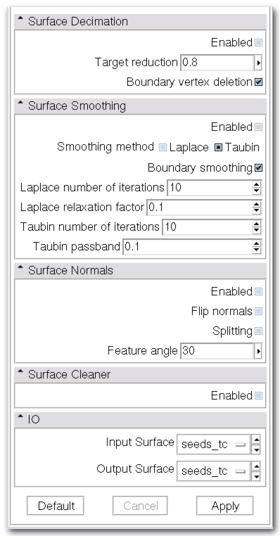|
|
| Line 64: |
Line 64: |
| | ** ''Input Surface'': the input surface | | ** ''Input Surface'': the input surface |
| | ** ''Output Surface'': the output surface, i.e. the input surface filtered through all the "Enabled" filters. | | ** ''Output Surface'': the output surface, i.e. the input surface filtered through all the "Enabled" filters. |
| − | |[[Image:screenshotBlankNotOptional.png|thumb|280px|User Interface]] | + | |[[Image:PythonSurfaceToolboxUI.png|thumb|280px|User Interface]] |
| | |} | | |} |
| | | | |
Revision as of 02:05, 29 April 2010
Home < Modules:PythonSurfaceToolbox-Documentation-3.6Return to Slicer 3.6 Documentation
Gallery of New Features
Module Name
Python Surface Toolbox
General Information
Module Type & Category
Type: CLI
Category: Surface Models
Authors, Collaborators & Contact
- Luca Antiga: Orobix Srl & Mario Negri Institute
- Daniel Blezek: Mayo Clinic
- Contact: Luca Antiga, luca.antiga@orobix.com
Module Description
This Python module provides several useful surface processing algorithms, namely decimation, smoothing, normal computation, surface cleaning.
Usage
Use Cases, Examples
- The module is appropriate when a surface has been extracted (e.g. with the Modelmaker module) but its appearance has to be improved.
Tutorials
NA
Quick Tour of Features and Use
A list panels in the interface, their features, what they mean, and how to use them. For instance:
- Surface Decimation:
- Enabled: enable topology-preserving surface decimation.
- Target reduction: target percentage reduction in number of triangles (this target reduction may not be achieved depending on the constraints on the topology).
- Boundary vertex deletion: allow deletion of points located on the boundary of the surface.
- Surface Smoothing:
- Enabled: enable surface smoothing.
- Smoothing method: choose between Laplace or Taubin surface smoothing algorithms (while Taubin is a non-shrinking filter, Laplace will tend to shrink the surface under the effect of curvature).
- Boundary smoothing: allow smoothing of points located on the boundary of the surface.
- Laplace number of iterations: number of iterations set when the Laplace algorithm is selected.
- Laplace relaxation factor: the factor by which a point moves towards the barycenter of its neighbors in the Laplace algorithm.
- Taubin number of iterations: number of iterations set when the Taubin algorithm is selected.
- Taubin passband: spatial frequency cutoff for the Taubin algorithm.
- Surface Normals:
- Enabled: enable computation of consistently-oriented surface normals (advised after smoothing - smoothing algorithms only move points and do not update normals accordingly, so the surface might still look non-smooth after smoothing when Gouraud shading is used).
- Flip normals: toggle direction of normals - the algorithm will do its best to orient the normals consistently "outwards" a surface, if the surface is orientable. This switch will make normals point "inwards"
- Splitting: toggle splitting of surface when angle between the normals of two neighboring triangles is above the Feature angle. This improves the shading appearance of sharp edges but produces topological holes in the surface.
- Feature angle: angle (in degrees) between two neighboring triangles beyond which the edge between the triangles is split.
- Surface Cleaner:
- Enabled: enable cleaning (merging of coincident points, elimination of unused points, treatment of degenerate cells) of the surface.
- IO:
- Input Surface: the input surface
- Output Surface: the output surface, i.e. the input surface filtered through all the "Enabled" filters.
|
|
Development
Notes from the Developer(s)
The module internally uses the following VTK filters:
vtkDecimatePro
vtkSmoothPolyDataFilter
vtkWindowedSincPolyDataFilter
vtkPolyDataNormals
vtkCleanPolyData
Dependencies
Python
Tests
NA
Known bugs
Follow this link to the Slicer3 bug tracker.
Usability issues
Follow this link to the Slicer3 bug tracker. Please select the usability issue category when browsing or contributing.
Source code & documentation
Links to the module's source code:
Source code:
More Information
Acknowledgment
NA
References
NA
